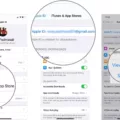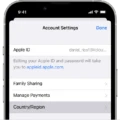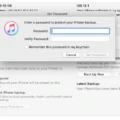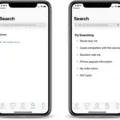The Mac App Store is an essential tool for Mac users to download and update applications. However, there are times when users encounter issues with the App Store, such as a blank screen or freezing. If you’re facing this problem, don’t worry, as there are simple fixes that can help resolve it.
One common solution is to sign out of your Apple ID and sign back in. To do this, open the Settings on your Mac and navigate to the iTunes & App Store section. Here, you’ll find your Apple ID. Click on it and select the option to sign out. Once you’ve signed out, open the App Store and wait for a few seconds for the content to load. Then, go to the Purchases section and sign back in with your Apple ID. This process might need to be repeated a few times if the App Store freezes or shows a black screen.
If signing out and signing back in doesn’t work, you can try force quitting the App Store. There are several ways to do this. One method is to use the Apple menu in the top-left corner of your screen. Click on the Apple logo and select the Force Quit option. In the window that appears, locate the App Store and click on it, then click the Force Quit button.
Another way to force quit the App Store is by using the Option + Command + ESC keys combination. Press and hold these keys together, and a window will appear showing the applications currently running. Find the App Store in the list and click on it, then click the Force Quit button.
If those methods don’t work, you can also force quit the App Store using the Mac Dock. Simply right-click on the App Store icon in the Dock and select the Force Quit option.
If none of these methods solve the issue, you can use the Activity Monitor to force quit the App Store. Open the Activity Monitor by searching for it in Spotlight or by navigating to Applications > Utilities > Activity Monitor. Once open, locate the App Store in the list of processes, select it, and click on the X button in the top-left corner to force quit.
After force quitting the App Store, relaunch it and see if the issue is resolved. Sometimes, you might need to try logging in a few times before the problem is fixed. Once you’re logged in, close the App Store if it’s open and open it again to check if you can see the Search Bar, categories, and other content.
If the blank screen issue persists, you can try turning off both your WiFi and Cellular Data connections. Then, try loading the App Store again. This can sometimes resolve connectivity issues that may be causing the blank screen problem.
If none of these solutions work, you can try resetting the App Store. To do this, open the Finder and click on “Go” in the menu bar. Select “Go to Folder” and type in “~/Library/Caches/com.apple.appstore”. Click “Go” and a folder will open. Inside the folder, click on the “com.apple.appstore” file and select “Reset” from the options list. Press the “Reset” button and then relaunch the App Store to see if the issue is resolved.
Encountering a blank screen or freezing issue on the Mac App Store can be frustrating, but there are several simple fixes that can help resolve the problem. By signing out and signing back in, force quitting the App Store, turning off internet connections, or resetting the App Store, you can often overcome these issues and get back to downloading and updating your favorite applications.
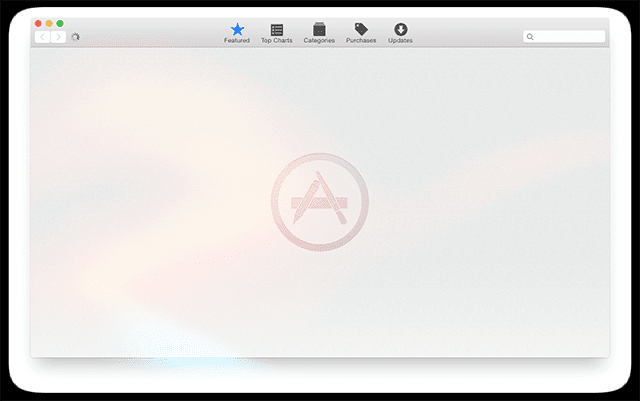
How Do I Fix The Blank Screen On My App Store?
To fix the issue of a blank screen on your App Store, follow these steps:
1. Open the Settings on your device.
2. Scroll down and tap on “iTunes & App Store” section.
3. Tap on your Apple ID, which is displayed at the top of the screen.
4. A pop-up window will appear with options, choose the “Sign Out” option.
5. Once you have signed out, go back to your home screen and locate the App Store app.
6. Tap on the App Store to open it.
7. Wait for a few seconds to allow the content to load properly.
8. Now, navigate to the “Purchases” section within the App Store.
9. Sign back in with your Apple ID credentials.
10. Once signed in, check if the blank screen issue has been resolved.
By following these steps, you should be able to fix the problem of a blank screen on your App Store.
Why Is My App Store Not Loading On Mac?
There can be several reasons why the App Store is not loading on your Mac. Here are some possible causes:
1. Internet connection issues: Ensure that your Mac is connected to the internet and that the connection is stable. A weak or intermittent connection can prevent the App Store from loading.
2. Apple server problems: Sometimes, the App Store may not load due to issues on Apple’s servers. This could be a temporary problem that will resolve itself after some time. You can check Apple’s system status page to see if there are any reported issues with the App Store.
3. Outdated macOS version: If your Mac is running an outdated version of macOS, it might not be compatible with the latest version of the App Store. Check for any available software updates for your Mac and install them.
4. Cache and temporary files: Over time, the cache and temporary files stored by the App Store can become corrupted, causing it to malfunction. Clearing the cache and temporary files may help resolve the issue. You can do this by opening the App Store and going to the “Store” menu, then selecting “Clear Cache” and “Clear Temporary Files.”
5. App Store preferences: In some cases, the App Store preferences may have become corrupted, leading to loading issues. You can try resetting the App Store preferences by quitting the App Store, opening the Finder, and navigating to “~/Library/Preferences/”. Locate the file named “com.apple.appstore.plist” and move it to the Trash. Then, relaunch the App Store.
6. Firewall or security software: If you have a firewall or security software installed on your Mac, it may be blocking the App Store from loading. Check your firewall settings or temporarily disable your security software to see if it resolves the issue.
If none of these solutions work, you may need to contact Apple Support for further assistance.
Why Is Apple App Store Blank?
The Apple App Store may appear blank for various reasons, which can range from temporary glitches to more persistent issues. Here are some possible explanations:
1. Network Connection Problems:
– Weak or unstable internet connection: If your internet connection is not strong or stable, it can prevent the App Store from loading properly, resulting in a blank screen.
– Disabled Wi-Fi or cellular data: If both your Wi-Fi and cellular data are turned off, the App Store won’t be able to connect to the internet and display its content.
2. App Store Server Issues:
– Temporary server outage: At times, the App Store servers may experience technical difficulties or maintenance activities, causing a blank screen. This is usually a temporary issue that resolves itself once the servers are back online.
– Regional server problems: Occasionally, specific regions may encounter server problems, leading to a blank App Store. This situation may require Apple’s technical team to address the issue.
3. Software Glitches:
– App Store cache issues: Temporary files and data stored in the App Store cache can sometimes become corrupted, causing the store to display a blank screen. Clearing the cache or restarting your device can help resolve this problem.
– Software bugs or conflicts: Occasionally, software bugs or conflicts with other apps on your device can interfere with the App Store’s proper functioning, resulting in a blank screen. Updating your device’s operating system or reinstalling problematic apps may help resolve this issue.
4. Account-related Problems:
– Apple ID authentication issues: If there are problems with your Apple ID authentication, such as incorrect login credentials or an expired session, the App Store may appear blank. Logging out and logging back in or resetting your Apple ID password can often resolve this problem.
– Account restrictions: In some cases, certain restrictions or parental controls set on your Apple ID may prevent the App Store from displaying its content. Adjusting the restrictions in your device’s settings can help resolve this issue.
To troubleshoot the blank App Store issue, try the following steps:
1. Check your internet connection and ensure it is stable.
2. Turn off both Wi-Fi and cellular data, then turn them back on.
3. Restart your device to clear any temporary glitches.
4. Update your device’s operating system to the latest version.
5. Clear the App Store cache by going to Settings > General > iPhone Storage (or iPad Storage) > App Store > Offload App.
6. Sign out of your Apple ID and sign back in.
7. Disable any restrictions or parental controls that may be affecting the App Store.
8. Contact Apple Support for further assistance if the issue persists.
Remember, these are general troubleshooting steps, and the exact solution may vary depending on the specific cause of the blank App Store problem.
How Do You Reset The App Store On A Mac?
To reset the App Store on a Mac, follow these step-by-step instructions:
1. First, open the Apple menu by clicking on the Apple icon in the top-left corner of your screen.
2. From the drop-down menu, select “App Store”. This will open the App Store application.
3. Once the App Store is open, locate the top menu bar and click on the “Store” option.
4. From the drop-down menu, click on “View My Account”. You may be prompted to enter your Apple ID and password.
5. After entering your credentials, a window will appear displaying your account information. Look for the “Reset” button and click on it.
6. A confirmation dialog box will pop up, asking if you want to reset the App Store. Click on the “Reset” button to proceed.
7. The App Store will now be reset to its default settings. This means that any customizations or preferences you had set will be reverted back to the original settings.
It’s important to note that resetting the App Store will not delete any of your installed apps or remove your Apple ID from the system. It simply resets the App Store’s preferences and settings.
By following these steps, you can easily reset the App Store on your Mac and start fresh with its default settings.
Conclusion
If you are experiencing issues with the App Store on your Mac, there are several troubleshooting steps you can try. First, you can sign out of your Apple ID in the iTunes & App Store section of Settings, then sign back in. This simple step can often resolve any freezing or black screen problems.
If that doesn’t work, you can force quit the App Store using various methods such as the Apple menu, the Option + Command + ESC key combination, the Mac Dock, or the Activity Monitor. After force quitting, relaunch the App Store to see if the issue is resolved.
If you are still having trouble, you can try logging in and out a few times, as this can sometimes help with persistent login issues. Additionally, turning off both your WiFi and cellular data connections before attempting to load the App Store may also be worth a try.
If none of these steps work, you can try resetting the App Store by selecting all app files in the Activity Monitor, choosing the Reset option, and pressing the Reset button. This can help resolve any underlying issues with the application.
Troubleshooting the App Store on your Mac can be frustrating, but by following these steps, you have a good chance of resolving the issue and getting the App Store back up and running smoothly.

